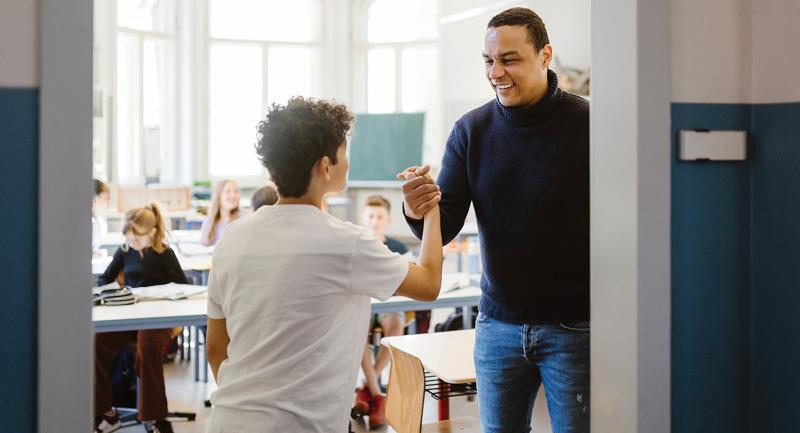A Principal's Story: As I (John) prepared to leave at the end of a long school day, a student I'll call "Carl" came running toward me across the asphalt, clearly upset and in tears. Shortly after, another student whom I'll call "Ron" came tearing across the yard in our direction. Ron was frequently referred to my office and well known for being aggressive, belligerent, and out of control. "I don't have any energy or empathy left in me to deal with this," I thought.
I body-blocked Carl and asked Ron, "What happened? Did you guys get in a fight?"
"No!" said Ron. "Move out of the way! I can help him!"
Surprised, I complied. Ron gently stood with Carl up against the wall and said, "Come, breathe with me. It will help you feel better."
As Ron led Carl in a few deep, deliberate breaths, Carl visibly calmed down. Before long, the two boys ran back across the schoolyard together.
The Power of Breath
What does a bit of breathing have to do with students feeling safe, valued, loved, and appreciated? Your breathing changes when you are sad, mad, happy, or nervous. Researchers have been studying this relationship for thousands of years, concluding that the connection between our nervous and respiratory systems is bidirectional (Seppälä, 2013). Our moods and feelings affect our breath regulation, and vice versa. So, if you change the way you breathe, you can change the way you feel. As two people who work in education (John is the principal of Park Middle School in Antioch, Calif., and Bidyut is the director of the Niroga Institute, a nonprofit that works with schools on mindfulness practices), we have seen firsthand the power of breath work in the lives of teachers and students.
Two years ago, we teamed up to help staff and students at Park Middle School implement the institute's Dynamic Mindfulness, or DMind, program—doing body and breath work to fill the mind with the present instead of thoughts about the past or future. The mindfulness movement has picked up steam in recent years, with many schools seeking out ways to incorporate practices like yoga and breath work into the classroom. These practices have changed Park Middle School's community in countless ways. Try It: Rhythmic Breathing, A Two-Minute Practice
At Park Middle School in Antioch, Calif., teachers use short breathing activities created by the Niroga Institute with students to help them feel calm and relieve stress. This exercise takes only a few minutes and requires no extra resources—just a quiet space to sit. Try it in your own classroom to start out the period or use it as a much-needed break.
Sit tall and comfortable, keeping your chest and abdomen relaxed.
When you feel mad, stressed, or anxious, breathe in to a count of four, and breathe out to a count of eight (about one count per second).
When you feel sad, depressed, or disengaged, breathe in to a count of four, and breathe out to a count of one (about one count per second).
Repeat the pattern up to 12 times, remaining aware of each breath as it is happening.
Mindfulness for Stress Resilience
When we ask educators if they or their colleagues are regularly stressed out, the answer is yes—predictably and unequivocally 100 percent of the time. Educators have too much work and too little time, which leads to a lack of work–life balance. Research in neuroscience shows that chronic stress, traumatic stress, and post-traumatic stress affect our brains and behavior, including the ability to self-regulate and have empathy (Davidson et al., 2012). Many school communities, including Park Middle School, also have a ubiquitous presence of psychological trauma. Some of our students experience abuse or neglect, difficult family situations such as a divorce, and stress from living in poverty. When educators serve children and families who experience stress or trauma, they imbibe it secondarily, just as naturally as taking in secondhand smoke. These stressors all take a toll.
The ABCs of Trauma-Informed Schools
The mindfulness program uses a three-part "A, B, C" solution: Act, Breathe, Center. Action or physical movement helps with stress resilience and healing trauma. Breath regulation enables emotion regulation. Centering practices enhance focus, attention, and engagement.
We began with several professional development trainings so that staff could practice DMind with students and use the techniques themselves. Instructors (including Bidyut) provided coaching and classroom lessons twice a week over the course of the year. We also created a wellness room where anyone can go to calm down or deal with stress. Some students go every day after lunch, a proactive alternative to discipline for those who need a transition time.
Now, moments of mindfulness (up to 15 minutes in a session) are interjected throughout the day and have led to dramatic decreases in absences, substantial reductions in referrals and suspensions, and academic improvement (Niroga Institute, 2018). They have also nurtured a more positive school culture. Students like Ron, who had previously acted out, use the techniques to improve their relationships and handle negative feelings. John sets the tone for school climate each day by using a chime over the PA system, reminding students to take a minute to breathe as the chime sounds. "I've seen more connections with students and staff," teacher Jessica Erickson said in a video interview (Niroga Institute, 2018). "And I've seen less frustration from staff, and that's probably connected to less frustration from students. We're moving in a positive direction." For a closer look at what mindfulness practices could do for your school, watch the video the institute made about Park Middle School's transformation (Niroga Institute, 2018). Such practices will enable you to set the tone for a healthier school. Editor's note: The names of the students have been changed to ensure their privacy.







